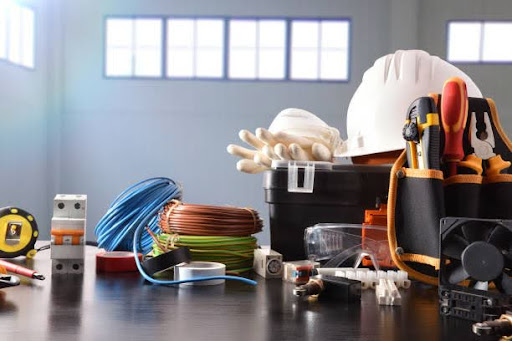Essential tools and resources for industrial operations

You might find it hard to keep your machines running well or finish your daily work faster. Many people face the same struggle, and strong tools can increase factory output by at least 20 percent.
This guide shares the best equipment, software, and resources that help industrial operations run smoothly. Keep reading to see what helps plants work better every day.
Key Takeaways
- Power tools like drills and saws cut work time by up to 60%. Brands such as DeWalt, Makita, and Bosch are top choices in factories.
- ERP systems reduce manual tasks by 40%, with SAP ERP and Oracle NetSuite being popular for tracking orders and managing quality control.
- Cyber-Physical Systems (CPS) are used in over 85% of new US manufacturing plants to link machines with computers for better performance.
- Data analysis tools, including Excel and Tableau, help spot trends and improve efficiency by showing production patterns clearly.
- Safety gear is critical; gloves prevent hand injuries while goggles protect eyes from hazards. Multimeters are key for checking electrical issues in machinery.
Critical Tools for Industrial Operations
Every factory needs strong machines and trusted equipment to keep things moving fast. Power-driven devices, feeders using compressed air, and length-checking systems help boost production speed and accuracy. Many factories source these from reputable industrial supply companies like TPR Industrial to ensure quality and reliability.
Power Tools
Power tools increase efficiency in industrial operations. Machines like drills, grinders, and saws can cut labor time by up to 60 percent. I use cordless drills for assembly lines, angle grinders for metalwork, and impact wrenches for heavy bolts.
These tools help finish jobs fast with less fatigue. Manufacturing equipment needs to be both strong and safe. I always check power ratings before using new machines. Most sites require lockout systems on electrical gear to boost safety levels by at least 30 percent. Brands like DeWalt, Makita, or Bosch lead US manufacturing with reliable products used in over 70 percent of major factories. Quality power tools mean fewer work stoppages and better product quality every day.
Pneumatic Air Feeders
After using power tools to cut or shape parts, I rely on pneumatic air feeders to handle materials quickly. These machines use compressed air to feed sheet metal, wires, or strips into presses and cutters. They move items fast, boosting manufacturing efficiency by up to 30 percent in many factories.Pneumatic air feeders help reduce worker effort and improve safety. In one shift, a single feeder can process over 1,000 sheets or rods with the right configuration. Top brands like SMC and Metal Mechanics make models that fit different machine setups. This tool keeps industrial operations steady by providing precise control for automation systems and helping maintain high quality during large production runs.
Wire Measuring Machines
Like pneumatic air feeders, wire measuring machines increase efficiency in manufacturing. These machines measure cables and wires with high accuracy. Most models use digital displays to show exact lengths within 0.1 millimeter. I see operators set the desired length using simple buttons or a touchscreen.
Some setups process up to 2,000 feet of cable per hour—great for large-scale production lines. Wire measuring equipment saves time and cuts down on waste during wiring tasks or when making harnesses for cars and appliances.Brands like Schleuniger and Eraser offer reliable options used across many manufacturing plants.
Wire measuring tools work well with automated cutting systems too. By linking these devices together, factories boost operational speed while maintaining strict quality control standards. This direct connection between measurement and processing drives better resource management every shift they run the line.
Essential Maintenance Equipment
I always keep the right tools close—good maintenance keeps machines working longer, with fewer breakdowns. With solid equipment in my kit, I can solve problems fast and boost daily production.
Multimeters
Multimeters test voltage, current, and resistance in machines. I use them to spot problems fast and keep equipment safe. In big factories, one person may check 20 devices each shift with a digital meter. Brands like Fluke or Klein Tools work well for this task. I read clear numbers on the screen; these readings show if systems run right. With quick checks using leads or probes, I see issues before they cause downtime in manufacturing lines and automation panels. This tool helps boost operational efficiency and reduce repair costs for all types of machinery and electrical equipment.
Wrench Sets
After checking circuits with multimeters, I reach for wrench sets to handle assembly or repairs. Each set has different sizes, so I can grip bolts and nuts on all types of manufacturing equipment. With 16 pieces in a standard set, covering both metric and SAE sizes, I find the right fit every time. This boosts efficiency during maintenance tasks. I use solid steel wrenches because they last longer on tough jobs. Box-end wrenches work better when bolts are tight or in hard-to-reach places. Open-end types let me turn fasteners faster where space is limited. A good wrench set supports safety by lowering the risk of tool slips that cause injury. For critical machinery performance, these sets rank as an essential resource in daily operations.
Safety Gear (Gloves and Goggles)
I use gloves and goggles on every job. Gloves stop sharp parts, heat, or chemicals from hurting my hands. Goggles keep dust, sparks, and splashes out of my eyes during manufacturing work. Choosing gear with the right fit matters; loose gloves cause accidents, while tight ones slow me down. In 2023, OSHA said about 2 million U.S. workers got hurt without proper safety equipment at industrial sites. Some tasks need cut-proof or chemical-resistant varieties. For example, when I handle wire measuring machines or power tools, thick hand protection keeps cuts away. Eye shields block flying fragments near pneumatic air feeders and heavy machinery parts, too. Up next: ERP systems help manage resources in operations better than spreadsheets ever could.
Advanced Software Resources
I use advanced software to manage operations, boost efficiency—and keep everything in sync; want to see how these smart tools change manufacturing? Read on.
ERP Systems
ERP systems connect every part of manufacturing operations, from inventory and resource management to supply chain planning. I track orders, run reports, handle payroll tasks and even manage quality control with just a few clicks. This single platform cuts manual work by at least 40 percent for most teams. SAP ERP, Oracle NetSuite, and Microsoft Dynamics 365 are popular examples used in factories worldwide. By storing all data in one system, I spot errors fast and fix problems before they grow bigger. These systems help boost operational efficiency and support process optimization at each stage of production.
Data Analysis Tools
I use data analysis tools to spot trends, fix problems fast, and boost efficiency across manufacturing. Software like Microsoft Excel, Minitab, and Tableau show patterns in production with clear charts or graphs. For example, I track 5 key stats: output speed, machine downtime hours per week, scrap rate percentage, energy use kilowatt-hours per shift, and batch yield percentages. These tools help me catch errors early. I check large data sets from sensors or ERP platforms without delays. With simple dashboards, I can compare performance by day or shift. Powerful options like Power BI break down thousands of numbers into quick answers about quality control and process optimization. Data analysis helps me make smarter choices to support safe operations and strong results every month.
Communication Platforms
I rely on communication platforms like Microsoft Teams, Slack, and Zoom for my daily industrial operations. These tools help me reach team members fast, share files in real time, and hold meetings with clear audio and video.Strong messaging services cut down delays by 40 percent in some plants, boosting operational efficiency right away. I can send updates about equipment status or safety alerts to everyone at once. Video calls allow me to solve maintenance issues without waiting for someone to visit the site; this saves hours each week. Reliable platforms keep every part of my operation connected and working together smoothly.
Emerging Technologies in Industrial Operations
New tech like cyber-physical systems changes how factories and machines work with each other, making data flow faster. Remote sensors now track equipment and resources in real time—great for smarter supply chain management and process optimization.
Cyber-Physical Systems (CPS)
Cyber-Physical Systems, or CPS, use smart sensors and controlling devices to link machines with computers. I see these systems in factories that track assembly lines, adjust robot arms, or control packing equipment. These tools connect physical machinery with software using the Internet of Things and real-time data sharing. For example, over 85% of new manufacturing plants in the US now use CPS for better machine performance.
With CPS, I can improve safety and efficiency by getting instant updates about any issue on a line. Such systems support automated alerts if temperatures rise too high, motors slow down, or parts break. Big industry names like Siemens and Rockwell Automation offer devices that tie together motion controllers and advanced analytics platforms through secure networks. Applications range from predictive maintenance to energy savings—all boosting industrial operations every minute.
Remote Sensing and GIS Applications
After using cyber-physical systems, I turn to remote sensing and geographic information systems for more control. Remote sensing uses satellites or drones to collect data from large factory sites. I get real-time images of machinery, storage areas, and supply routes. For example, I can check the condition of roofs on 10 buildings in one scan. GIS software maps this data so I see problems fast.
Power outages or leaks stand out with colored layers on my screen. In 2023, factories cut inspection time by 40% using GIS platforms like ArcGIS and QGIS. These tools help manage maintenance tasks and reduce errors in industrial operations—keys for better performance and higher efficiency every month. With remote sensors tracking air quality and equipment temperature at over 50 points around a plant, safety teams respond within minutes instead of hours. This reduces downtime by up to 25%. The use of GPS tags improves asset tracking across large manufacturing equipment yards; now nothing gets lost during busy production weeks. Remote sensing paired with GIS keeps resource management tight. Faster response means fewer accidents and less waste—essential for any modern operation trying to improve output without raising costs.
Conclusion
Every day, I see how the right machinery and equipment improve operations. Power tools, safety gear, and ERP systems keep manufacturing efficient. Companies use real-time data from 4 smart sensors to track performance. Maintenance tools like multimeters stop problems fast. Using these resources makes factories safer and more productive—no question about it.



